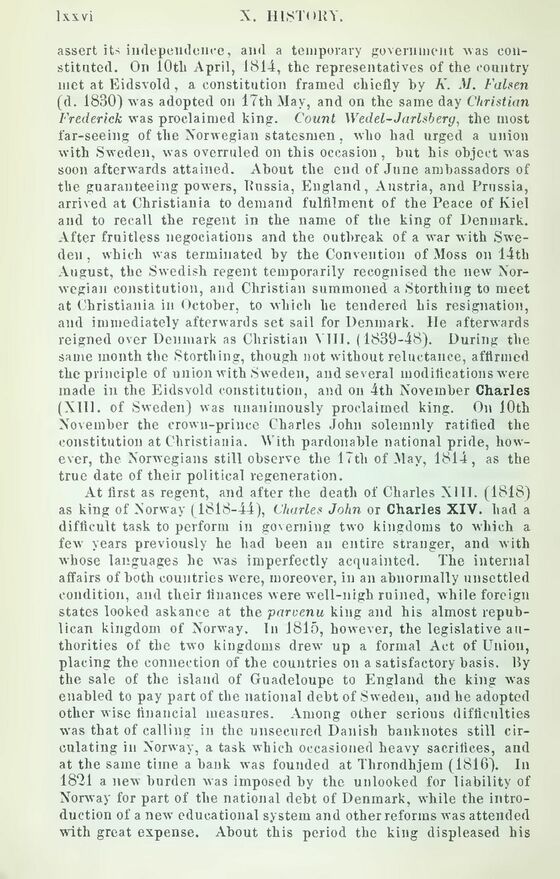
Full resolution (JPEG) - On this page / på denna sida - Introduction - Pages ...

<< prev. page << föreg. sida << >> nästa sida >> next page >>
Below is the raw OCR text
from the above scanned image.
Do you see an error? Proofread the page now!
Här nedan syns maskintolkade texten från faksimilbilden ovan.
Ser du något fel? Korrekturläs sidan nu!
This page has never been proofread. / Denna sida har aldrig korrekturlästs.
assert its independence, an«l a temporary government was
constituted. On 10th April, 1814, the representatives of the country
met at Eidsvold, a constitution framed chiefly hy K. M. Falsen
(d. 1830) was adopted on 17th May, and on the same day Christian
Frederick was proclaimed king. Count Wedel-Jarlsberg, the most
far-seeing of the Norwegian statesmen, who had urged a union
with Sweden, was overruled on this occasion, hut his object was
soon afterwards attained. About the end of June ambassadors of
the guaranteeing powers, Russia, England, Austria, and Prussia,
arrived at Christiania to demand fulfilment of the Peace of Kiel
and to recall the regent in the name of the king of Denmark.
After fruitless negociations and the outbreak of a war with
Sweden , which was terminated by the Convention of Moss on 14th
August, the Swedish regent temporarily recognised the new
Norwegian constitution, and Christian summoned a Storthing to meet
at Christiania in October, to which he tendered his resignation,
and immediately afterwards set sail for Denmark. lie afterwards
reigned over Denmark as Christian VIII. (1839-48). During the
same month the Storthing, though not without reluctance, affirmed
the principle of union with Sweden, and several modifications were
made in the Eidsvold constitution, and on 4th November Charles
(XIII. of Sweden) was unanimously proclaimed king. On 10th
November the crown-prince Charles John solemnly ratified the
constitution at Christiania. With pardonable national pride,
however, the Norwegians still observe the 17th of .May, 1814, as the
true date of their political regeneration.
At first as regent, and after the death of Charles XIII. (1818)
as king of Norway (1818-44), Charles John or Charles XIV. had a
difficult task to perform in governing two kingdoms to which a
few years previously he had been an entire stranger, and with
whose languages he was imperfectly acquainted. The internal
affairs of both countries were, moreover, in an abnormally unsettled
condition, and their finances were well-nigh ruined, while foreign
states looked askance at the parvenu king and his almost
republican kingdom of Norway. In 1815, however, the legislative
authorities of the two kingdoms drew up a formal Act of Union,
placing the connection of the countries on a satisfactory basis. By
the sale of the island of Guadeloupe to England the king was
enabled to pay part of the national debt of Sweden, and he adopted
other wise financial measures. Among other serious difficulties
was that of calling in the unsecured Danish banknotes still
circulating in Norway, a task which occasioned heavy sacrifices, and
at the same time a bank was founded at Throndhjem (1816). In
1821 a new burden was imposed by the unlooked for liability of
Norway for part of the national debt of Denmark, while the
introduction of a new educational system and other reforms was attended
with great expense. About this period the king displeased his
<< prev. page << föreg. sida << >> nästa sida >> next page >>